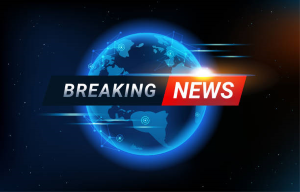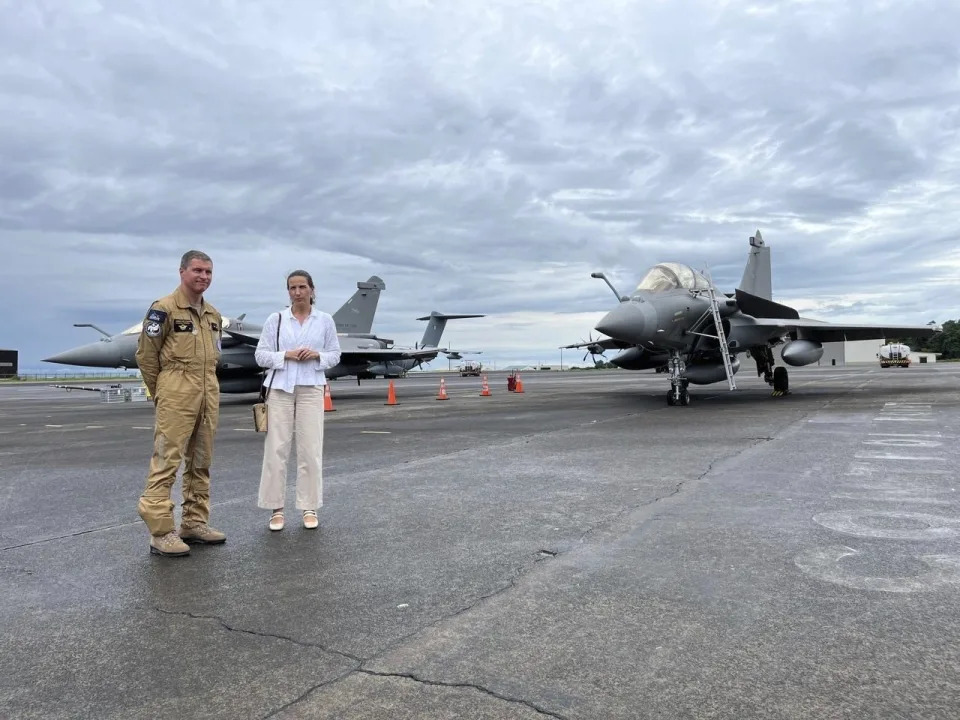French air force Brig. Gen. Guillaume Thomas, left, and French Ambassador to Manila Marie Fontanel stand in front of French-made Rafale fighter jets as a nannual French air force mission called Pagase takes place at Clark air base, in Pampanga Province, north of Manila, Philippines, Sunday July 28, 2024.
France renewed a commitment to help defend freedom of navigation and overflight in the Asia-Pacific Sunday and said that its supersonic fighter jets — a pair of which landed for the first time in the Philippines — and advance military power would enable it to respond rapidly to any humanitarian or security crisis in the region.
France is also working to quickly conclude a defense pact that would allow it to deploy a larger number of forces for joint exercises to the Philippines, French Ambassador to Manila Marie Fontanel said.
France has moved to broaden its defense engagements in the Indo-Pacific region, including with the Philippines and other Southeast Asian nations.
That dovetails with the effort of the administration of Philippine President Ferdinand Marcos Jr. to boost his country’s territorial defense by allowing a larger US military presence in the Philippines under a 2014 defense agreement and by building security alliances with Asian and Western nations as it deals with China’s increasingly assertive actions in the disputed South China Sea.
An annual French air force mission called Pegase, which showcases its combat power and travels to friendly countries to deepen defense relations, arrived over the weekend at Clark air base, a part of the former U.S. Air Force base, north of Manila, with two French-made Rafale fighter jets and air force cargo and transport aircraft.
The French air force flew a small group of journalists, including from The Associated Press, aboard an Airbus A400M cargo aircraft over Philippine waters facing the South China Sea Sunday to demonstrate its crucial capability to undertake aerial refueling. But pockets of turbulence prompted the French military to abort the maneuver for safety reasons.
Philippine air force personnel will also get the chance to fly onboard the Rafale jets and familiarize themselves with the aircraft. The fighter jets have been a “game changer," French air force Brig. Gen. Guillaume Thomas, who was heading the air force mission, told a news conference.
“They enable us to go very far and very fast and to be able to react very quickly…in case of a humanitarian crisis or even security crisis,” Thomas said. “We are able to deploy forces from France to be in this area in the Pacific in a very short notice.”
The French air force mission “is not designed to target any specific country or any specific situation” and does not aim to escalate regional tensions, Fontanel said.
France and the Philippines have begun preliminary talks on a status-of-forces agreement that would provide a legal framework and enable troops from each country to hold exercises in the other’s territory. France has been tasked to finish an initial draft of the agreement by September that would be the basis of future talks, Fontanel said.
Aside from France, the Philippines has been holding separate talks with Canada and New Zealand for such agreements. It signed a similar pact with Japan earlier this month.
China has strongly criticized such alliance-building and large-scale U.S. military exercises in the Philippines, saying the Philippines is “ganging up” with countries from outside Asia, and warned that military drills could instigate a confrontation and undermine regional stability.
Philippine military officials have dismissed China’s criticism, saying the drills and alliances are aimed at boosting Manila’s territorial defense and are not directed at any particular country.
AfriPrime App link: FREE to download...
https://www.amazon.com/Africircle-AfriPrime/dp/B0D2M3F2JT
Philippine forces sail to hotly disputed shoal without incident for first time since deal with China
Philippine government personnel transported food and other supplies Saturday to a fiercely disputed shoal occupied by a Filipino navy contingent but closely guarded by Beijing’s forces in the South China Sea and no confrontations were reported, Philippine officials said.
It was the first Philippine government supply trip to the Second Thomas Shoal, which has been the scene of increasingly violent confrontations between Chinese and Philippine forces, since the Philippines and China reached a deal a week ago to prevent clashes, the Department of Foreign Affairs in Manila said in a statement.
"The lawful and routine rotation and resupply mission within the Philippines’ exclusive economic zone is a credit to the professionalism of the men and women of the Philippine navy and the Philippine coast guard and the close coordination among the National Security Council, Department of National Defense and the Department of Foreign Affairs,” the Philippine Foreign Affairs Department said, without providing other details.
A top Philippine security official told The Associated Press that the Chinese and Philippine coast guards communicated for coordination Saturday, and their ships did not issue two-way radio challenges like in the past to demand that each other's ships leave the shoal immediately.
Also, for the first time at the shoal, Chinese coast guard ships did not shadow or block the Philippine vessels as they had repeatedly done in the past, said the official, who spoke on condition of anonymity because of a lack of authorization to discuss the delicate issue publicly.
China’s coast guard said the Philippine ship delivered daily necessities “in accordance with a temporary arrangement reached between China and the Philippines.”
“The China Coast Guard confirmed it, supervised and managed the entire process,” spokesperson Gan Yu said in a statement posted online.
The deal was reached by the Philippines and China after a series of meetings between the two country's diplomats in Manila and exchanges of diplomatic notes aimed to establish a mutually acceptable arrangement at the shoal — which Filipinos call Ayungin and the Chinese call Ren’ai Jiao — without conceding either side’s territorial claims, Philippine officials said.
The deal has not been made public by either side.
U.S. Secretary of State Antony Blinken welcomed the news that the resupply mission was completed without a confrontation.
"We applaud that and hope and expect to see that it continues going forward,” said Blinken, who was in Laos for a meeting of foreign ministers of the Association of Southeast Asian Nations, a group that includes the Philippines.
China's coast guard and other forces have used powerful water cannons and dangerous blocking maneuvers to prevent food and other supplies from reaching Filipino navy personnel at Manila’s outpost at the shoal, on a long-grounded and rusting warship, the BRP Sierra Madre.
In the worst confrontation, Chinese forces on motorboats repeatedly rammed and then boarded two Philippine navy boats on June 17 to prevent Filipino personnel from transferring food and other supplies, including firearms, to the ship outpost in the shallows of the shoal, according to the Philippine government. The Chinese seized the Philippine navy boats and damaged them with machetes and improvised spears. They also seized seven M4 rifles, which were packed in cases, and other supplies. The violent faceoff wounded several Filipino navy personnel, including one who lost his thumb, in a chaotic skirmish that was captured in video and photos that were later made public by Philippine officials.
China and the Philippines blamed each other for the confrontation and each asserted their own sovereign rights over the shoal.
The United States and its key Asian and Western allies, including Japan and Australia, condemned the Chinese acts at the shoal and called for the rule of law and freedom of navigation to be upheld in the South China Sea, a key global trade route with rich fishing areas and undersea gas deposits.
In addition to China and the Philippines, Vietnam, Malaysia, Brunei and Taiwan have been locked in separate but increasingly tense territorial disputes in the waterway, which is regarded as a potential flashpoint and a delicate fault line in the U.S.-China regional rivalry. The U.S. military has deployed Navy ships and fighter jets for decades in what it calls freedom of navigation and overflight patrols, which China has opposed and regards as a threat to regional stability.
Washington has no territorial claims in the disputed waters but has repeatedly warned that it is obligated to defend the Philippines, its oldest treaty ally in Asia, if Filipino forces, ships and aircraft come under an armed attack, including in the South China Sea.
AfriPrime App link: FREE to download...



